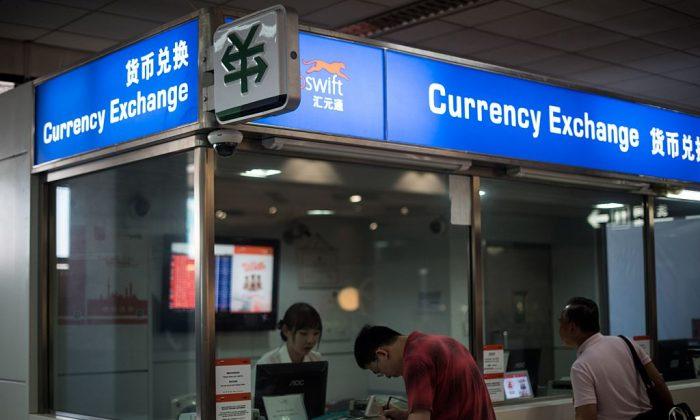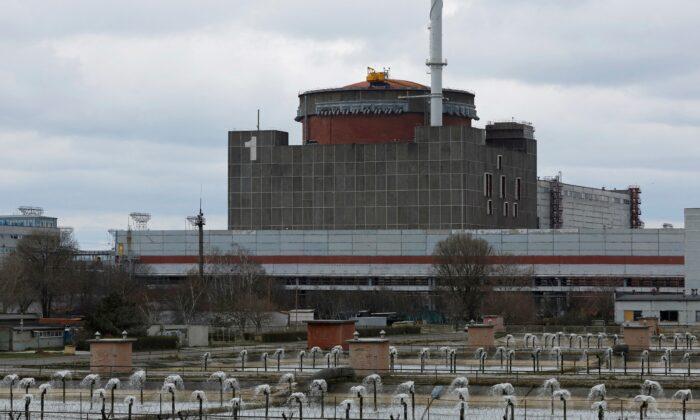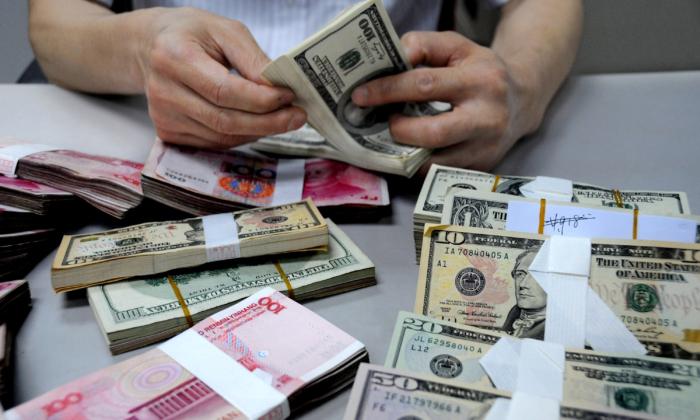China has had a long-standing problem of cash leaving the country. Much of the outflow is the result of corrupt officials transferring state-owned assets overseas. Last month, China’s central bank released a report on monetary policy that says stronger supervision has been implemented. But China experts doubt that it can prevent the ongoing flight of capital.
Red Families and Underground Banks
According to Xie Tian, a Chinese Economics professor at South Carolina Business School, stronger supervision cannot fundamentally solve the problem of China’s capital flight.“The CCP’s [Chinese Communist Party] regulation can only restrict some officials and ordinary people,” Xie told The Epoch Times. “As to the powerful families who really control China’s economy, they can use the so-called ‘open and honest way’ to arrange for the flight of funds. These families don’t need to use underground banking services. The scale of capital flight depends on how much money they have in their hands, and regulatory policies cannot limit them.”
These people, especially those who own high-tech companies, can illegally transfer large sums of money overseas through acquisition companies, Xie said. They can change the purchase price from $100 million to $150 million through acquisition companies in the United States and thereby move large sums of money through what appears to be a normal transaction.
In 2021, China made large foreign exchange transactions from profits made from the pandemic, he said.
Xie also believes that almost the entire wealth of these powerful families has already been transferred abroad.
China’s 2021 international balance of payments statement showed a trade surplus of $554.5 billion, the second highest in history.
As to middle- and lower-level CCP officials and ordinary people, although the amounts these individuals are sending abroad is relatively small, combined dollar value becomes very large, Xie said. Underground banks are one of the ways for this group to transfer money internationally.
There is no way of knowing the exact amount of China’s capital outflow, but judging from just the amount exposed in the underground bank crack-downs, the scale is huge, far exceeding the net errors and omissions in China’s international balance of payments.
Massive Capital Flight Since 1990s
China’s capital flight has a long history. A 2006 article by the Chinese Academy of Sciences Journal, titled “The Channels, Scale and Countermeasures of Our Country’s Capital Flight,” stated that the scale of China’s capital flight has maintained an upward trend since the 1990s, and the estimated capital flight in 1998 was nearly $87 billion. The total outflow from 1997 to 2002 exceeded the sum of inflows of foreign direct investment (FDI) and external debt during the same period, the article said.The article also said that an investigation report by the International Monetary Fund pointed out that the large-scale capital flight was an important potential cause for the 1994 financial crisis in Mexico, the 1997 Asian financial crisis, and the 1997-1998 financial crisis in Russia. However, China’s short-term capital flight per unit of GDP from 1996 to 2002 was higher than that of Mexico and South Korea when the financial crises occurred in those countries in 1994 and 1997, respectively. The main reason why China did not have a financial crisis in 1997 was primarily because its capital market had not been opened, and also because of the large inflow of capital at that time.

The article did not mention underground banks when naming the methods of capital flight, but the number of underground banks that have been discovered involve hundreds of billions of dollars. According to information released by the CCP’s Central Bank and state media in October and early November 2015, 92 underground banks were identified between April and October 2015, involving more than 800 billion yuan (approx. $128 billion).
According to the report, bank staff were also involved in the business chain of underground banks.
For example, in the case of a large underground bank in Shenzhen that was busted in June 2015, the amount involved more than 12 billion yuan (approx. $1.92 billion). Shen Mousheng, the then-president of a Shenzhen Baoan Bank sub-branch, offered to use an underground bank to transfer huge sums of money overseas for Hong Kong businessman Chen Da. A large number of “customers” involved in the case confirmed that they found the underground bank through a bank employee or other acquaintance or friend.
China’s balance of payments net errors and omissions in 2014 were $140.1 billion. Although the 2014 Balance of Payments Report issued by China’s Administration of Foreign Exchange on March 31, 2015, said that error and omission amount didn’t equal the scale of capital flight, beginning in April 2015, China’s Central Bank led a special campaign to stop the use of offshore companies and underground banks that transfer funds overseas.
At the same time, in 2015, Chinese residents used credit cards to move cash overseas frequently and on a large scale. On Sept. 30, 2015, China’s Foreign Exchange Administration issued a document limiting the amount of overseas withdrawals. Net errors and omissions in 2015 were negative $188.2 billion, an increase of 34 percent from 2014. The analysis in the 2015 Balance of Payments Report was that in 2015, Chinese residents spent up to $133 billion on overseas credit cards, and that the foreign exchange bureau issued a document on Sept. 30 to limit the number of overseas cash withdrawals.
China’s foreign exchange regulation has gradually been escalating.
On Jan. 1, 2016, the monitoring system for running a personal foreign exchange business was officially launched nationwide, and the use of the personal foreign exchange settlement and sales management information system was discontinued. Individuals who borrow other people’s quotas for foreign exchange settlements and sales were directly included in the “Watch List.” Chinese residents have an annual exchange quota of $50,000.
The website of China’s State Information Center published an article on Feb. 23, 2017, titled “The Reasons and Countermeasure Suggestions for the Continuous Outflow of Cross-border Funds in Our Country.” The article said, “In recent years, the pressure of cross-border capital outflow has been great, and it is an all-round capital flight.” “The outflow of ‘hot money’ through informal channels is also intensifying.”
An analysis by Goldman Sachs’ Gao Hua, based on the regime’s official data, and market and third-party financial statistics, shows that in cross-border capital outflows, domestic capital outflows play a greater role than foreign capital withdrawals.
China analyst Zhang Tianliang researched Chinese capital flight in 2020. According to the report released by Global Financial Integrity (GFI) on Oct. 25, 2012, between 2000 and 2011, by comparing the import and export volume announced by the CCP and other countries, $3.2 trillion exited China through false invoices. Adding in other means of flight, GFI estimated that between 2000 and 2011, capital flight from China was as high as $3.79 trillion.
Chinese Capital Flows Into US Real Estate
A lot of the capital leaving China has entered the U.S. real estate market where it has pushed up home prices in some cities.A Sept. 1, 2020 article by the Wharton School of the University of Pennsylvania titled “How foreign purchases of U.S. homes impact prices and supply,” said that Chinese residents’ investment in U.S. housing partly reflects China’s capital outflows in recent years; a large part of it is wealthier Chinese residents who move their money abroad to evade taxes and avoid censorship at home.
The authors, Benjamin Keys, a professor of real estate at the school, and Caitlin Gorback, a doctoral student at the school, also co-authored a research paper titled “Global capital and local assets: House prices, quantities, and elasticities,” published in June 2020 by the National Bureau of Economic Research.
The study concluded that foreign investors, especially Chinese, buying homes in the United States, pushed up prices, making housing affordability even more of a concern. For example, between 2012 and 2018, areas with more non-U.S.-born Chinese experienced home price growth 8 percent higher than other areas.
Keys said that in the United States, cities that provide job opportunities have a crisis of housing affordability, because the increase in new housing cannot keep up with the increase in employment; and foreigners buying houses may worsen local housing affordability. Chinese buyers led foreign investment in U.S. housing from 2013 to 2019. He cited a report by the National Association of Realtors (NAR) saying that between 2019 and 2020, Chinese home purchases amounted to $11.5 billion, slightly more than one-sixth of total foreigner purchases.
Notably, Chinese investors spent nearly $32 billion in the U.S. real estate market in 2016-2017. Why, then, did home purchases fall by nearly two-thirds in 2019-2020?
According to Xie Tian, Economics professor at South Carolina Business School, there are two reasons. One is that the U.S.-China trade war started in 2018, and China’s trade revenue has decreased. The other reason is that the CCP has strengthened supervision. For example, the management of officials’ passports became stricter, and many ways of doing overseas related deals are now restricted; even if ordinary people have an annual exchange quota of $50,000, it’s very difficult to do. And rich people are also restricted from buying overseas life insurance.
But public information shows that under this strong supervision, the scale of China’s underground banks seems to also have grown.
The large group of underground banks cracked in Qitaihe City, Heilongjiang Province in 2019 involved more than 1.0 trillion yuan (approx. $160 billion), exceeding the 2019 current account balance of $141.3 billion. According to official disclosures, it was the largest underground bank case in Chinese history. The case involved 68 underground bank criminal gangs, more than 300 customs brokers, and over 1,300 companies in over 20 Chinese provinces, autonomous regions and municipalities, and hundreds of people.
On Feb. 8, 2021, the CCP’s official media outlet China Discipline Inspection and Supervision News published an article titled “Cut off the outflow channel of corrupt assets.” The article disclosed that in the four years from 2017 to the reporting date, more than 6,000 cases of illegal foreign exchange trading in underground banks were investigated and dealt with, an average of more than 1,500 cases per year. In 2019, more than 440 major underground banks were found, and more than 1,200 criminal suspects arrested, exceeding the number in 2016. In 2016, over 380 major underground bank cases were cracked, more than 800 criminal suspects arrested, and the total transaction amount involved exceeded 900 billion yuan (about $144 billion).
As for the overall possible impact of Chinese capital flow into the United States, Xie said that, because the capital entered the United States, it’s an investment for the United States and a good thing.
According to data released by the U.S. Bureau of Statistics on Feb. 7 this year, the U.S. merchandise trade deficit with China rose by $45 billion in 2021, up 14.5 percent to $355.3 billion—the largest deficit since 2018.
U.S. officials said China has fallen short of its Phase 1 trade deal commitment to buy an additional $200 billion in U.S. goods and services in 2020 and 2021. However, Chinese capital flight into the United States can undoubtedly make up, or partially make up, for the losses caused by Beijing’s breach of commitment.





